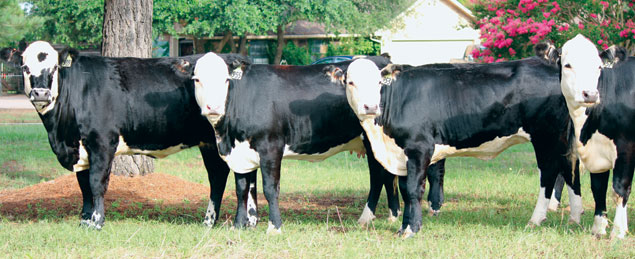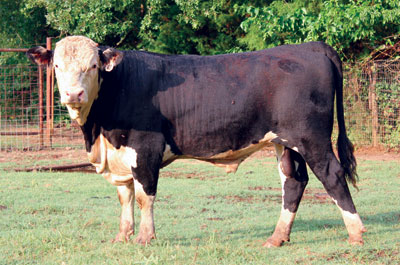
Bobby Lide
Photo by Sarah Harris
Texas cattleman Bobby Lide may see the cattle business as black and white, but his approach is anything but straightforward.
Bobby is one of a handful of breeders across the country raising Black Herefords, a fairly new breed of cattle with origins stemming from two very strong, storied and popular breeds of beef cattle — Angus and Hereford. By emphasizing genetics, Bobby and his son, Jared, are building a herd well suited for their needs, and having a good time doing so.
“To be able to build something is a lot of fun,” Bobby says.
What Is a Black Hereford?
Bobby has raised cattle most of his adult life, but just began raising Black Herefords in 2009. Retired from a full-time position with his family’s storage-tank manufacturing business, he decided he wanted to dig a little deeper into his hobby. He researched many breeds and came across Black Herefords, which he felt combined the most positive traits of each of the two breeds used to make the crossbreed. Hereford cattle are well known for being docile and maternal, which Bobby was drawn to, but he also liked the higher premiums that Black Angus cattle tend to bring at market.
“The Hereford breed has done a really good job with their research, and the Angus breed has done a great job with marketing,” Bobby says of the combination.

Black Herefords from the Lides' herd. While Black Herefords typically have the traditional white markings of Hereford cattle, their markings can vary slightly from animal to animal.
Photo Courtesy of Triple L Ranch
But finding Black Hereford breeding stock was not easy. He began searching for mature Black Hereford cows, but could not find an established breeder who would sell animals of that age. Not wanting to take on the risk and maintenance of raising heifers, he continued looking and eventually convinced a nearby breeder to sell him five cows. Bobby and Jared then enlisted the help of the executive director of the American Black Hereford Association (ABHA) in Leavenworth, Kan., and were able to purchase cattle from several breeders across the country. Today, the Lides’ herd of approximately 130 Black Hereford cattle includes cows and bulls from herds in Kansas, Iowa, California and Texas.
Where Science Meets Business Sense
Genetics always plays a big role in any cattle operation, but especially in one like the Lides’, which is built on a new breed with limited supply.

A Black Hereford bull from the Lides' herd
Photo Courtesy of Triple L Ranch
“I can’t just buy a bunch of cows and throw a couple of bulls out with them,” Bobby says. “There is some figuring that has to go in with it, and that’s the fun part to me — the genetics.”
To be registered as a Black Hereford, an animal has to have more than 62 percent Black Hereford breeding. To achieve this percentage, it usually takes three generations and begins with a Hereford (usually a female) mated with an Angus animal (usually a male). This result is commonly referred to as a Black Baldy and is a popular crossbreed in the United States. The Black Baldy must then be mated with a registered Hereford or registered Black Hereford for its offspring to be registerable.
Using a Game Ranch to Build a Cow-Calf Herd
Despite the cattle being a hobby for the Lides, they are still a business. Bobby has relied on the ABHA for some assistance in locating and marketing cattle, and has used genetic testing to determine which traits are being passed through his herd, including hair color and ribeye size.
“I still look at the bottom line and am pretty careful about what I buy,” he says.
In addition to acreage near his home in Mexia, Texas, Bobby and his brother, Billy, own a 5,000-acre game ranch in East Texas, where he raises some of the cattle. After weaning this year’s calf crop, he put a new plan in place to use the game ranch, Heart’s Bluff, for the breeding and calving seasons, and then to bring the cattle to his home base for marketing.
The brothers purchased Heart’s Bluff in 2004 with financing from AgriLand Farm Credit. At that time, the ranch had been severely mismanaged and overhunted. The Lides immediately began making improvements. As part of their wildlife management plan, they established food plots and decided not to high-fence the property. Today, Heart’s Bluff is a licensed hunting preserve and a part of the Texas Parks and Wildlife Level 3 Managed Lands Deer Program. In addition to deer, the ranch is home to wild hogs, quail, Eastern turkeys, ducks, dove and several breeds of exotics.
“The ranch has taught me a lot of patience,” Bobby says. “When you do something on a ranch, it takes a year or two or three to see if what you did is going to even work. And I’ll admit, that drives me crazy.”
Unconventional Methods Are Paying Off
In line with breeding Black Herefords, Bobby also uses an uncommon method of planned grazing on a portion of his land. He grazes 33 head of cattle near his home on 40 acres that is divided into ten 4-acre lots. The cattle graze on each lot for one week, before being transferred to another parcel. “This was the best way I knew how to graze this many cattle for this long,” he explains.
After all the emphasis that he has put on the herd’s genetics, Bobby feels that the efforts have paid off — and he’s enjoyed it too.
“It took almost a year to put them all together, but now I’m through,” he says. “I’ve got just what I want.”
– Staff
Only 68 Breeders Nationwide
According to the American Black Hereford Association’s website, the Lides are one of only 11 registered Black Hereford breeders in Texas. There are 68 registered breeders nationwide.
The American Black Hereford Association was established as a nonprofit corporation in 1994, but the first cattle to qualify for registration were recorded in 1997. The association installed customized breed software in 2000, enabling it to track herd and breed-wide performance and generate registry certificates. Three years later, the breed
received international breed designation (HB) from the National Association of Animal Breeds.
For more information, visit the American Black Hereford Association’s website atwww.blackhereford.com.